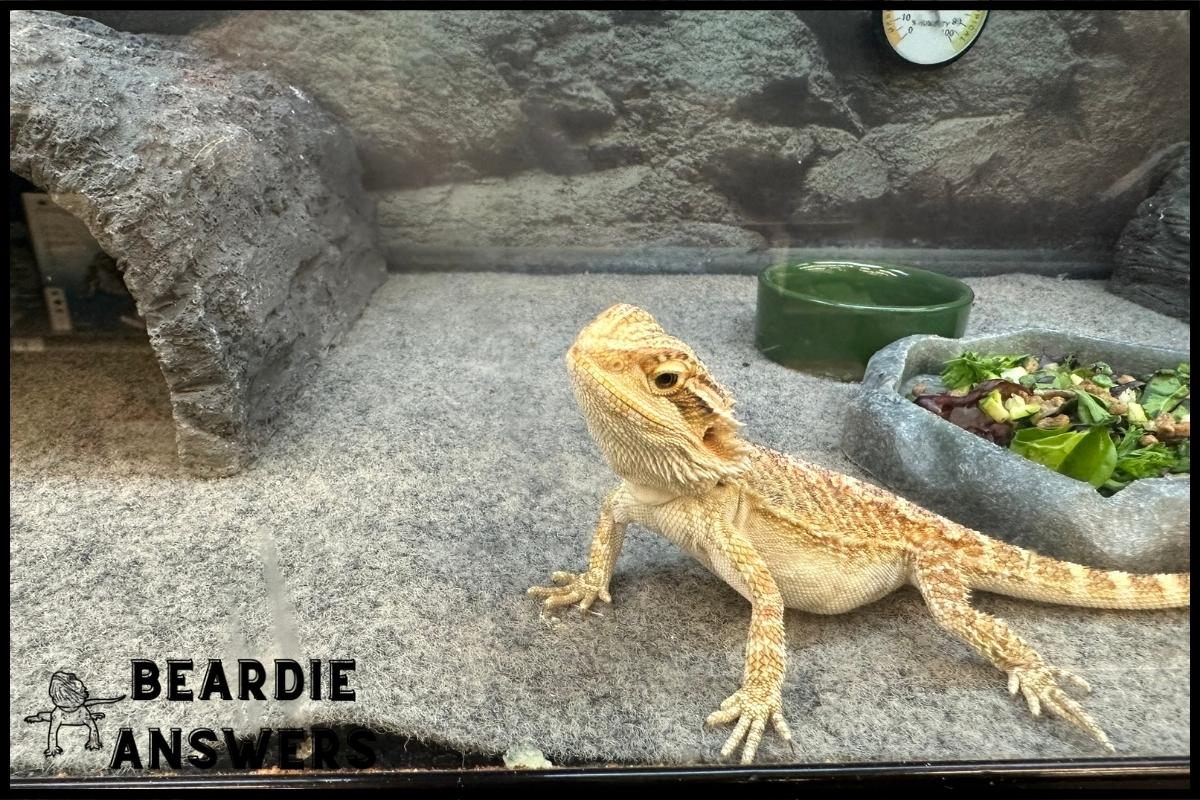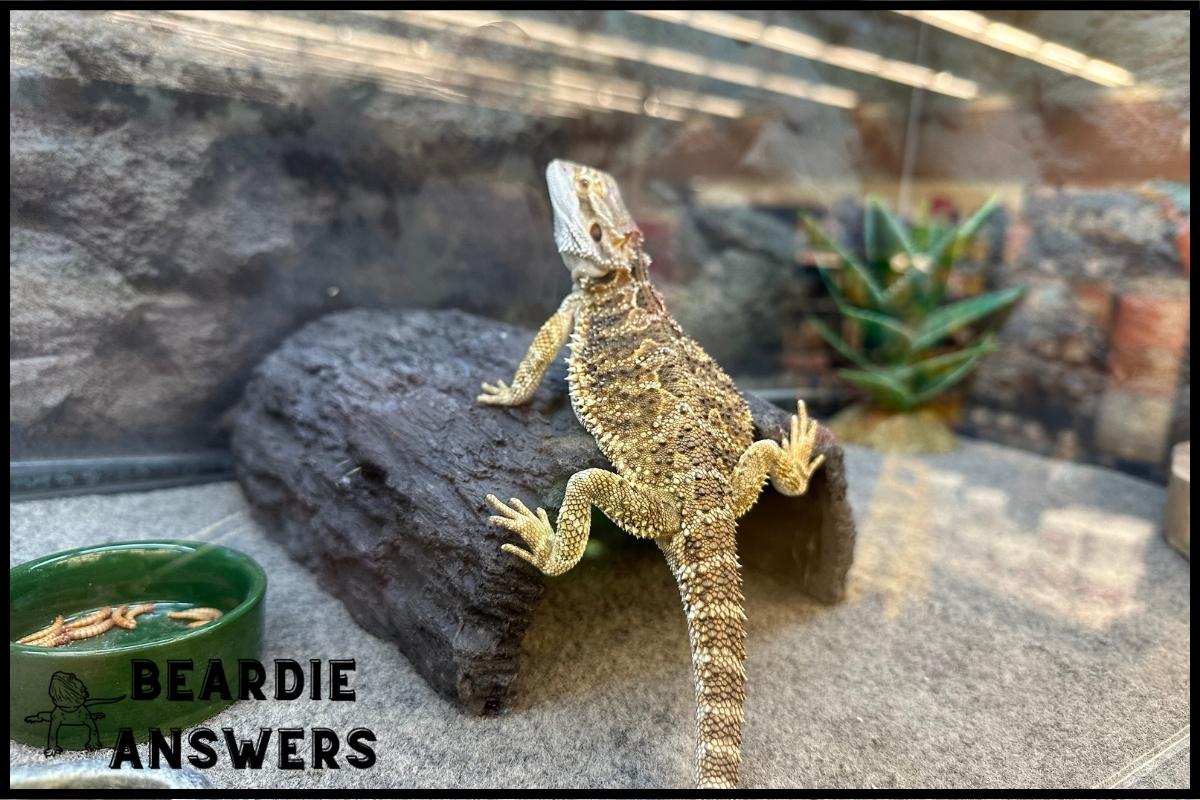Bearded dragons can carry salmonella bacteria in their digestive system, which can be transmitted to humans through contact with their feces or other bodily fluids. It is important to practice good hygiene and handling techniques when caring for a bearded dragon to minimize the risk of transmission.
What You'll Learn
What Is Salmonella?
Salmonella is a dark, menacing force that lurks in the shadows of our food supply. It’s an unwelcome guest at dinner tables and kitchen counters alike – silently waiting to infect unsuspecting victims through contaminated food or water.
Salmonella can cause severe illness and even death if left unchecked; it’s why we must remain vigilant when it comes to food safety and infection control.
The risk of salmonella contamination has far-reaching consequences for all types of animals, including bearded dragons.
So what are the chances of your beloved pet becoming infected? Let’s take a closer look to find out.
Are Bearded Dragons Prone To Salmonella?
Salmonella is a bacteria that can cause food poisoning in humans and animals. It is found in the feces of infected animals, which can then contaminate the environment or other animals when those feces are ingested. As such, salmonella infections can be difficult to avoid even if one practices good hygiene and handling techniques.
Bearded dragons are particularly susceptible to salmonella due to their lack of immunity against certain strains. In addition, these reptiles may be exposed to environmental contamination through contact with soil, water, or fecal matter from an infected animal. While bearded dragons have been known to develop infections from salmonella, there are still ways that owners can reduce their pet’s risk of getting sick from this potentially harmful bacteria.
By providing clean living conditions for your pet and practicing proper hygiene before and after handling them, you can help limit their chances of coming into contact with contaminated materials. Regularly cleaning cages, bowls, toys and other items used by the dragon will also help minimize potential exposure to salmonella-causing bacteria. With these precautions in place, it is much easier to keep your pet healthy and safe from infection.
Moving forward however, understanding how salmonella transmission occurs between species is key to preventing future illnesses – both among pets and people alike.
Salmonella Transmission
The dangers of salmonella in bearded dragons are real, and the potential transmission of this harmful bacteria is something all owners must consider.
But what environmental risks pose a threat to these lovable reptiles? And how can diet management help protect them from harm? The answers may surprise you.
Environmental factors that put bearded dragons at risk for salmonella include contact with other animals, such as rodents or birds, who could be carrying the bacteria without showing any symptoms themselves. Additionally, exposure to contaminated surfaces like cages, bedding materials, food dishes, and water sources has also been known to increase the likelihood of infection.
It’s important to remember that even healthy looking dragon enclosures can harbor dangerous microorganisms if not regularly cleaned and disinfected.
Therefore, it is crucial for owners to take steps towards reducing their dragon’s chance of coming into contact with salmonella by employing proper diet management practices. This includes providing your pet with fresh vegetables free from dirt or contamination and avoiding raw meats which have an especially high risk of containing harmful bacteria.
By following these simple guidelines in addition to regular cleaning protocols, reptile owners can ensure their beloved lizard remains safe and healthy. Transitioning now into prevention & hygiene practices…
Prevention & Hygiene Practices
The risk of salmonella transmission from bearded dragons can be greatly reduced by practicing proper hygiene and handling techniques. It is important to maintain a clean habitat for your bearded dragon, including cleaning the enclosure regularly and providing enough space in the cage for them to move around freely. Additionally, it is essential that you wash your hands thoroughly before and after contact with your pet.
Taking these precautions will go a long way towards keeping both you and your reptile healthy.
Another helpful habit when caring for a bearded dragon is to keep their food dishes separate from other items in their environment. This will help reduce any potential contamination of their food by bacteria or parasites. It’s also wise to use different sets of tongs, spoons, and other utensils when feeding them so as not to spread germs between feedings.
By taking these simple steps, you can ensure that your beloved pet stays safe and free from infection.
With regular attention paid to care habits like habitat hygiene and enclosure cleaning, owners are much less likely to encounter problems related to salmonella in their bearded dragons. However, it’s still critical to be aware of signs & symptoms should they arise so prompt action may be taken if necessary.
Signs & Symptoms Of Salmonella In Bearded Dragons
Gastrointestinal symptoms of salmonella in bearded dragons can include vomiting, diarrhea, loss of appetite, and dehydration.
Respiratory symptoms may include coughing, sneezing, and wheezing.
Skin symptoms can include rashes, swelling, and scabbing.
Gastrointestinal Symptoms
If your bearded dragon is showing signs of gastrointestinal symptoms, it could be a sign of salmonella.
Dietary changes and environmental factors can play a role in the development and spread of salmonella so it’s important to pay attention to how much food you’re giving them and what kind of environment they are living in.
Be sure to monitor their diet for any changes or health issues that may arise.
If these symptoms persist, contact a vet right away as there could be other underlying causes causing the discomfort.
Respiratory Symptoms
In addition to gastrointestinal symptoms, respiratory issues can also be a sign of salmonella.
Sneezing, coughing and difficulty breathing are all signs that your bearded dragon might have contracted this bacterial infection.
Vaccination risks should be taken into consideration as well since some vaccinations may increase their susceptibility to developing the infection.
Environmental exposure is another factor to consider when diagnosing salmonella – if they come in contact with other infected animals or surfaces, it could lead to them becoming ill.
It’s important to watch for any changes in behavior or health so you can get help right away if necessary.
Skin Symptoms
It’s also essential to watch for skin symptoms, as these can be signs of salmonella.
Shedding causes and diet changes are common in infected dragons, so if you notice your pet shedding more than usual or eating less than they normally do, it could indicate a problem.
Additionally, redness or irritation around the eyes and mouth may appear due to bacterial infection.
If any of these signs present themselves, it is important to take them to the vet immediately as salmonella left untreated can have serious consequences.
Treatment For Salmonella In Bearded Dragons
The treatment for a bearded dragon infected with salmonella is much like the way one would treat any other infection or illness: rest, proper nutrition and support. It’s not as straightforward as simply taking a pill; it requires patience and diligence to ensure that your pet is getting what they need in order to get better.
Just like human beings, animals can become more susceptible to illnesses if their environment isn’t kept clean and free of contamination sources. It’s important to practice good sanitation practices around them, such as regularly cleaning cages, bowls and toys, while also vaccinating against serious diseases which could affect their health.
Sometimes even when you do everything right, things don’t go according to plan – so prevention is always preferable to cure. The best thing you can do for your beloved pet is make sure its enclosure is maintained properly and provide regular veterinary check-ups in case there are signs or symptoms of an underlying condition that needs attention.
Vaccination should be taken into consideration too, because it gives extra protection from some of the most common infections out there. With all these preventive measures combined together – along with lots of love and care – we can help our pets stay healthy for many years to come!
It may seem easy enough on paper but in reality, providing adequate care for a beardie takes time and effort on both parts – yours and theirs! However, the rewards outweigh any minor inconveniences tenfold when you consider how happy they’ll be living life comfortably within their own safe space at home.
So let us take this opportunity to give them the best chance possible by investing in knowledge about their needs today!
Conclusion
In conclusion, it is important to take proper safety precautions when handling bearded dragons in order to reduce the risk of salmonella transmission.
By following good hygiene practices, such as washing your hands thoroughly after each interaction and avoiding contact with bearded dragon feces, you can prevent contamination from occurring.
Additionally, be sure to keep an eye out for signs of infection – if you suspect that your beardie has been exposed to salmonella, seek veterinary care right away.
With the right knowledge and a little bit of extra caution, you’ll be able to make sure your beloved pet stays healthy and happy!

Hi! My name is Bryan, I am the “one behind the words” here are BeardieAnswers.com. I believe that providing quality care and nutrition is the best way to ensure the health of your pet. Every beardie is special and deserves the best care and attention. If you have questions about your bearded dragon, please don’t hesitate to ask! View My Full Author Page




